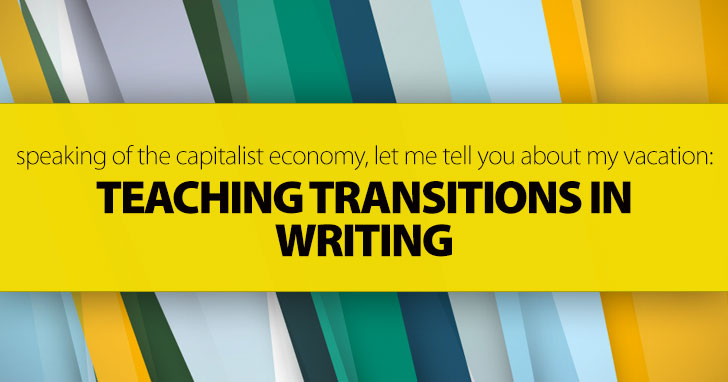My First Car was Unreliable: A Car was Ugly, Too. Teaching Devices for Coherence and Cohesion


I used to think it was sleep disorder and Attention Deficit (ADD) problems, but then realized it really was the writing. Sometimes the logical connections that students make, or apparent lack thereof, consume enormous amounts of the reader’s energy due to the effort needed to make those connections and some sense out of the writing.
Although often seen as tangential to writing, an afterthought tacked on the end of a chapter in writing texts under “connecting words” such as “therefore” and “although,” understanding and using logical connections are major writing tasks, going to the heart of the reader-writer relationship. The reader doesn’t have insight into a writer’s train of thought, and it’s the writer’s responsibility to make connections between ideas clear for the reader.

Problems with transitions and connections in writing fall into several categories which follow:
A colleague recently received a copy of a letter from a student written to an administrator, complaining about her, the instructor. The student wrote “I wasn’t able to finish my work because Professor Applebaum assigned it in the lab.” Upon questioning this apparent non sequitur, Dr. Applebaum found what the student meant was that she, the teacher, had given a writing assignment in the language lab, so the complaining student tried to complete it in the lab, but the lab was too noisy, so she went home to finish it, but there were too many distractions there, too, ultimately causing her poor grade on the paper and in the class. Not understanding that the reader will not see how the writer got from Point A to Point Z, from the assignment of the paper to ultimately failing the assignment, without help from the writer is a major problem with lack of transitions specifically and student writing in general.
The connection of a conclusion to its underlying assumptions and support is something that is also often missing in student writing. Students make such claims as the capitalist economy is the best in the world and then breeze forward with examples of not only the freedom to start a business but also to go to school, freely choose a profession, and enjoy life in general. All of that may be true, but the student hasn’t proven it, as I point out, asking first about the underlying assumption that it’s the capitalist economy that yields all of these benefits. Students sometimes get impatient, believing they don’t have to make those connections: “It’s a given!” one student exclaimed. Well, it really isn’t, to many people, I had to explain. He was eager to continue discussing more of the myriad benefits of capitalism, but his first task as a writer was in demonstrating that capitalism was indeed responsible for those benefits as well as defining what such terms as “enjoying life” meant.
Sometimes making connections and showing transitions is as simple as putting elements in the correct order. Many writers at even an advanced level seem to have trouble with what should be relatively simple: putting your writing in the correct sequence. I recently had the experience of having to look up online two processes that government offices are responsible for: replacing a lost passport and obtaining a driver’s license. It took several hours in each case to put together the needed information as it was scattered across several websites and out of order. Writers should not make understanding that hard on the reader: if you are writing about a process, put the steps of that process in sequence and organize it in the same place. If you are telling a story, start from the beginning and proceed to the end; results usually follow causes, and so forth. This is true unless the writing is creative and consciously nonlinear.
Although it may appear an insurmountable task connected to the writer’s very thought processes, the teacher can help students to make logical connections and transitions apparent to the reader.

The first step is raising student awareness that readers do not have insight into writers’ thought and their connections, so those connections must be shown explicitly. Teaching students to visualize a specific audience can help in this regard as students can consider what this audience will easily understand and where they might need more help in making connection.
Also important is creating an audience within the classroom, with students reading each other’s work and pointing out where communication breaks down.
Have students question their own underlying assumptions : “What does ‘capitalism’ mean here, and how does it connect to freedom?” “Will the reader understand these steps and be able to follow them?” and so forth.
The language of logical connections goes beyond throwing in transition words such as “because” and “however” now and then. It also includes building connections with the use of synonyms, repetition, and organization that will help the reader follow the writer’s train of thought. Taking the paper on the virtues of capitalism, for example, the writer could build connections with repetition of and synonyms for “capitalism,” such as “the free market.” The use of specific “transition” words now becomes secondary as the connections demonstrated through linking ideas throughout the text.
The organization of the ideas is also paramount, starting with a definition of capitalism before moving into its effects, explaining clearly the causal link between each of the different advantages of capitalism located in their own paragraphs. Again, if the organization is already solid, there is less need for transition words to make it explicit.